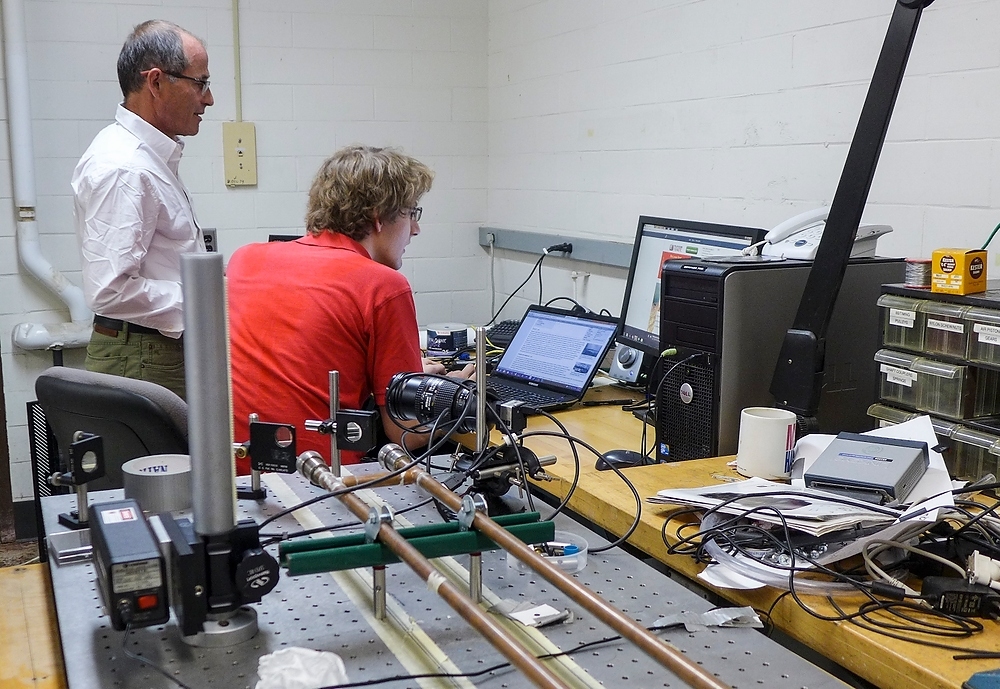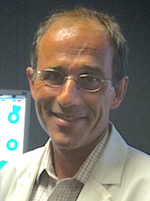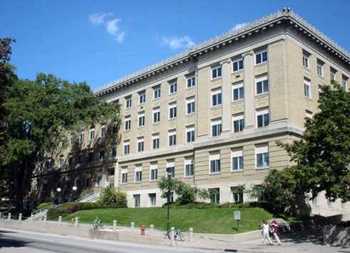‘Garage Physics’ is a makerspace for undergraduate brainstorms

Duncan Carlsmith (left) discusses an advanced search engine with Josh Cherek, the student who developed it, at the Garage Physics makerspace. The twin copper pipes in the foreground replicate an 1851 experiment that Albert Einstein cited as one foundation for his special theory of relativity.
Photo: David Tenenbaum
To physics professor Duncan Carlsmith, a student’s proposal to make a four-rotor helicopter drone was fine fodder for what he calls “garage physics.” But why stop at a quadcopter, he told the University of Wisconsin–Madison undergraduate. Make one that is mind-controlled, so a person with severe movement impairment could think: “Go open the fridge and show me what’s inside,” and that would actually happen.
And, oh yes — round up some more undergrads, have them build it in one semester, and with the help of undergrad business students, draft a business plan: Would anybody want to buy such a brilliant drone?
Of course there were a few challenges, but that’s really the point, says Carlsmith, who runs Garage Physics, a makerspace in the bowels of Sterling Hall. “Just try something. It doesn’t really matter what it is. Make it fun, and low cost.”

Duncan Carlsmith
Although the EEG mind-controlled quadcopter project did not result in a spinoff company, two physics student collaborators in Copenhagen began developing the copter for use finding some of the 40 million land mines strewn around old battlefields.
Garage Physics is located in the room where, in the 1940s, Professor Ray Herb invented a high voltage ion beam accelerator used by the Manhattan Project to invent the atomic bomb. That accelerator supported a successful spinoff: 90 employees at National Electrostatics Corporation in Middleton, Wisconsin, make the latest versions of Herb’s device.
The Garage Physics program was inspired by one who got away, says Carlsmith, who teaches modern physics, including topics like relativity and quantum theory. “I had an engineering student who was interested in all kinds of things. We chatted about modeling the human body and a year later, he was at Sector67 (another Madison makerspace) using a 3-D printer to prototype low-cost prosthetic hands for people in Third World countries.”
Eric Ronning, the undergrad in question, is now running his third venture, with support from UW–Madison’s Discovery to Product program. “Eric was my inspiration,” Carlsmith says. “I wanted a place for project-oriented learning, for off-the-wall ideas that are not part of the usual professor’s interests. I vowed there would be a home for the next creative, motivated kid.”

Sterling Hall, home of Garage Physics.
Garage Physics supports independent research and entrepreneurial student research and development, with about a dozen undergraduates active at any one time. One of them, Josh Cherek of Spencer, Wisconsin, is taking advantage of the space’s computers to develop a unique type of search engine. “I’ve been making things as far back as I can remember,” he says. “In high school, I got a used server and was setting up websites. But coming to college, you don’t have a workspace, and the Garage is a really cool opportunity to have one.”
The Garage has also housed a sustainability class, taught with collaborators Giri Venkataramanan, professor of electrical and computer engineering, and Erica Halverson, associate professor of education. Projects included a computer-controlled countertop hydroponic greenhouse that could grow lettuce in a couple of weeks, and a gray-water recycling system to purify shower water and send it to the toilet (after it was sterile enough for a dog to drink).
As a ringmaster of this undergraduate creativity, Carlsmith relishes his role as brainstormer.
As a ringmaster of this undergraduate creativity, Carlsmith relishes his role as brainstormer. Could the swarm of X-rays released when Scotch tape is pulled off a surface in a vacuum allow a soldier to X-ray a wound in the field? Whether the idea would work is secondary, Carlsmith explains. “Working on these ideas, a physics student could learn about X-rays and vacuum pumps, and simultaneously about the market and entrepreneurship. Maybe he or she could run with it, or maybe it’s just something to try out as an undergrad.”
Visualizing and creating a radical high-tech product can change a student’s life, Carlsmith says. “They begin to realize, ‘I am actually a real person with my own unique talents.’ Many past students from the Garage are flying. They will graduate and do great things.”
And then Carlsmith returns to what he does best: spinning a recent advance in technology into fun, achievable projects for motivated undergrads. “Google wants to give Wi-Fi access to everybody, based on balloons. We’ve already launched two high-altitude balloons, looking for cosmic rays using smartphones. … There are a lot of applications. Two years ago, scientists found bacteria living in the upper atmosphere. Where are they coming from? You could get into all kinds of cool science.”
Tags: physics, research, spinoffs, student life, student resources




